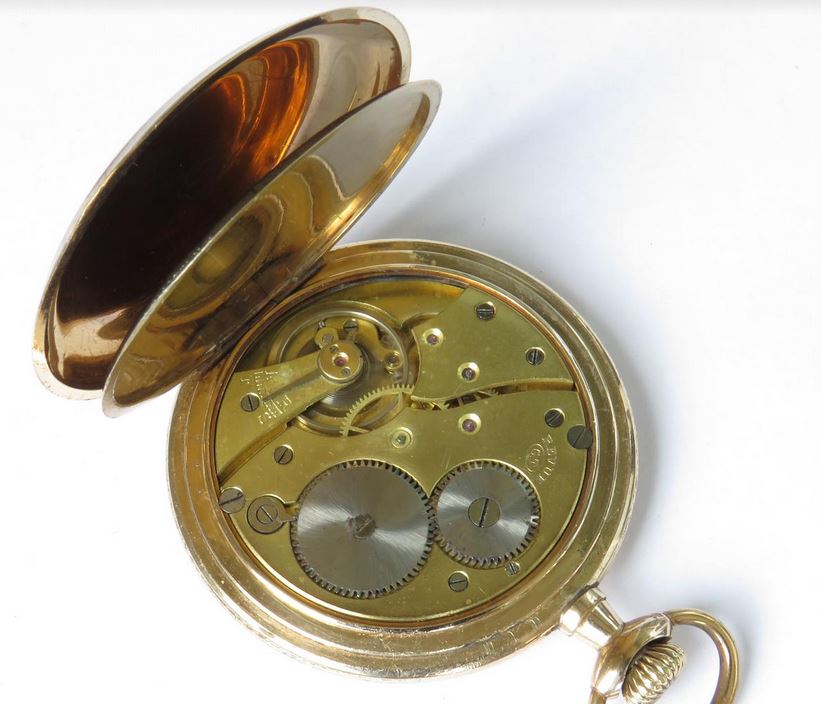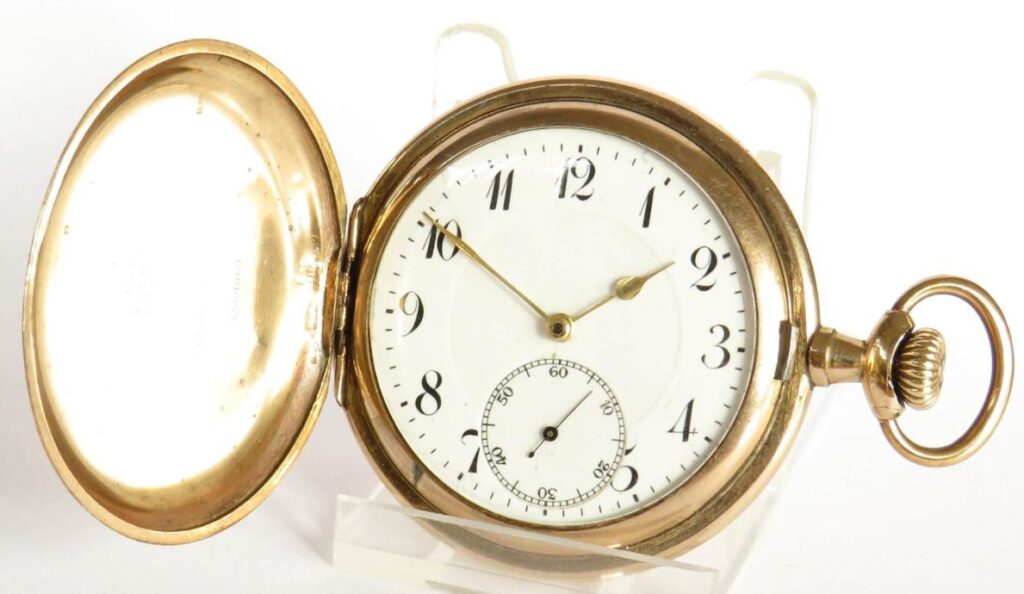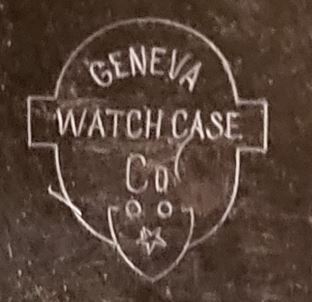Last updated on April 28, 2024
As I have mentioned in many of my previous posts, I enjoy researching antique watches as much as I enjoy wearing them. This particular watch, a Revue full hunter pocket watch, c1910, has an interesting history. It comes from a very respected watchmaker, with a long and well-documented history. It also has a watch case which comes from a little-known manufacturer, the Geneva Watch Case Co., that has a somewhat obscure history. Very little is documented online regarding the history of this company. I spent many hours scouring the internet for snippets of information, all of which had little or no supporting sources. What little I have learnt about the Geneva Watch Case Co. is documented below.
Movement
The watch has a high-quality Revue 30 hunter calibre 15-jewel movement. Enhancements to the lever movement include a Breguet overcoil hairspring and a bimetallic compensated screw balance. The movement is marked with the Revue and GT brand names. The British Merchandise Marks Act of 1887 required that the company of origin should be marked on all imported goods. Neither the dial nor the movement is marked “Swiss made” indicating that this watch was made for European markets, but ended up in Britain.
Gédéon Thommen
The municipality of Waldenburg, Switzerland, profited from the important Basel – Geneva trade route for centuries. The constant traffic supplied the town with a steady income. However, in the 1850s the trade route was disrupted when the Basel-Olten railway line bypassed the town. As a result, the townspeople decided to turn to the watchmaking industry as an alternative source of revenue. The “Société d’Horlogerie à Waldenburg” (Waldenburg clock and watchmaking company) was formed in 1853 to assemble pocket watches from ebauche movements. However, the company struggled financially and the business was sold in 1859 to a businessman, Gédéon Thommen. The company was renamed to “Gédéon Thommen – Uhrenfabrikation” (watchmaking). After restructuring by Thommen, the business began to recover, focussing attention on improved manufacturing methods to produce high-quality watches. Its primary brand name was GT.
Revue
In 1890, Gédéon Thommen died and his son Alphonse took over the company. At this point, the company was producing approximately 13,000 timepieces a year using either cylinder or lever movements. In 1905 Alphonse Thommen renamed the company “Thommens Uhrenfabrik AG”. Depending on the source referenced, the “Revue” brand name was registered either in that same year or several years later, possibly 1908 or 1910. However, most sources agree that the company operated under the name Revue Thommen from 1910 onwards.
Case and dial
The watch measures 52mm in diameter excluding the winding stem and the loop. The case is gold-filled which means it is made of a material consisting of a brass centre sandwiched in between two thinner layers of gold. The case also has engine-turned detail to both the front and back, along with a vacant cartouche to the front. There are a couple of tiny pin prick marks on the case back near the hinge. However, these can be regarded as patina.
Otherwise, the case is in very good condition. The winding crown pushes in to open the front cover. Inside, there is a glass crystal which is in excellent condition. The double-sunk enamel dial is crisp and clean with Arabic numerals. Overall, the dial is in excellent condition with a few marks that are only visible under magnification. The watch has its original gilt gold hands and a blued steel sub-seconds hand.
The Geneva Watch Case Co.
The gold-filled case was made by the Geneva Watch Case Co., otherwise known as Manufacture Genevoise de Boites de Montres (MGBM). However, not much is known about the company. According to Mikrolisk the first trademarks for the Geneva Watch Case Co. were registered in 1909. Additional trademarks appeared to be registered up until 1944, from this time onwards I cannot find any record of the company. The particular maker’s mark that appears on this watch was registered in 1912.
The company address according to catalogue entries and advertisements was 80 Rue de Saint-Jean, Geneva. The early trademarks were associated with two individuals Pierre-A. Dérobert and J. Dérobert. These individuals were further associated with the two companies, Pierre-A. Dérobert & Cie and Dérobert Freres (brothers). I can only assume that the Dérobert companies owned the Geneva Watch Case Co. There was a further reference to a Dérobert Fils (sons) in a 1936 statement from The Geneva Federation of Employee Companies. They reported that “The staff of the Geneva Watch Box Manufacture (Dérobert & Fils) rue de St-Jean, 80, in Geneva, has been on strike since November 16, 1936.” It is most likely that the two brothers joined forces to run the Geneva Watch Case Co. and eventually the business was taken over by their sons. However, as I mentioned earlier, I can find no trace of the company beyond 1944.
Gold filled case
The Geneva Watch Case Co. have a specific system for identifying the quality of a gold-filled case. Beneath the Geneva Watch Case Co. wording on the case is a shield. The shield contains a number of stars. Each star represents 10 years of guarantee for the life of the gold-filled case. The year guarantee is a measure of quality. In theory, the company would replace the case if the gold wore through to the brass during the guaranteed period.
The Geneva Watch Case Co. made cases guaranteed for 10, 20 and 30 years. The dots above the shield indicate the gold karats used in the gold-filled layer. It ranges from 5k, 10k, 14k to 18k. In this instance, the shield contains one star inside which means it has a guarantee of 10 years (which is also engraved on the case). The two little dots above the stars indicates 10 karat gold-filled layers. The brass is in no way exposed on the case, which means it has lasted a century beyond its initial guarantee.
Summary
An antique Revue-Thommen pocket watch has been on my wish list for a long time. It is an iconic Swiss brand and a must-have for any serious collector of antique pocket watches. This watch is very presentable and practical. It has passed a timekeeping test with excellent results. It runs approximately 1 minute fast over a 24-hour time period, with a power reserve of 32 hours. This is a very respectable result for an antique timepiece. The watch sits ticking loudly at my desk as I type. I have already worn it on several occasions and look forward to continued use in the years to come. This Revue full hunter pocket watch is a very welcome addition to my collection.




I wonder if you can help me. I have inherited a similar Revue pocket watch. The movement is marked Revue and it has a gold hunter case, marked Dennison Watch Case Company, it is the Moon brand. The watch is running slow, about 10 minutes a day. What could cause this? Can this be fixed? How much is the watch worth? How old is the watch? Any help is appreciated, Loren.
Hi Loren, Revue is a well respected Swiss watchmaker, so you have inherited a good quality antique pocket watch. The Dennison Watch Case Company was a prolific maker of watch cases in various materials. They started using the Sun, Moon and Star brands of gold-filled cases around 1901. I will try to answer your questions in order. There are a number of things that could cause your watch to run slowly, please take a look at this post: Why does an antique pocket watch run slow? The fact that it is running is a good sign. A service by a qualified watchmaker will likely get is running to a good level of accuracy for an antique watch (+/- 1 minute a day or better). In terms of value, please take a look at this post: How to value an antique pocket watch. I always say that the sentimental value of an antique watch will generally outweigh the monetary value. Look at completed auction results for similar pocket watches for the best idea. In terms of age, I would suggest early 20th century, after 1901 but pre 1920. I hope all of this helps and thanks for commenting, Jason
Thank You for the article, especially for info about the Geneva Watch Case Co, it helped me to identify that the wristwatch I bought recently has 5k gold-filled case.
I would like to ask if You know something about Sergines brand – the only info I found is that, at some point, it became the Longines trademark, however there are no too many examples of Sergines watches (especially wristwatches) online.